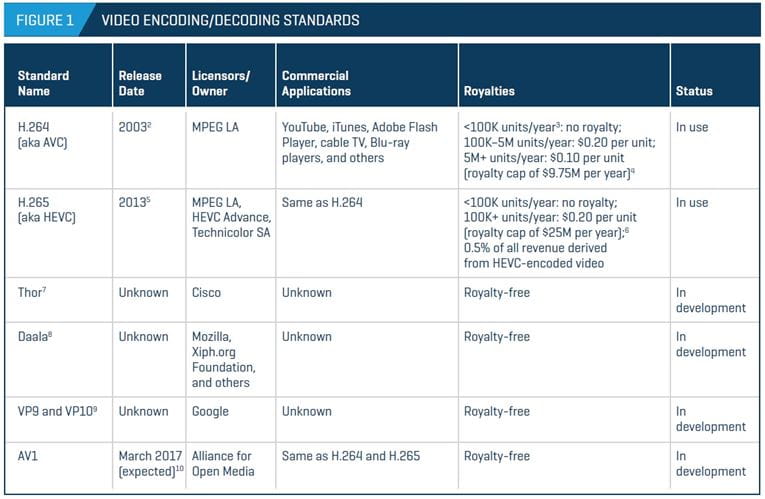The Alliance for Open Media The Latest Challenge to Patent Pools
The Alliance for Open Media The Latest Challenge to Patent Pools
The tech giants’ strategy to avoid licensing fees – despite the risks – could lay the groundwork for similar alliances in other industries.
The Alliance for Open Media (AOM) represents the latest challenge to patent pool licensing. Frustrated with licensing fees that they perceive to be unreasonably high, tech titans such as Microsoft, Amazon, Google, and Intel created AOM to develop and release a royalty-free, technically superior version of two widely used video encoding/decoding (codec) standards, H.264 and H.265. Although the success of AOM has yet to be determined, it will be interesting to see whether this challenge to the patent pool licensing business model spreads to other industries such as telecommunications, security, transportation and logistics, energy generation and distribution, and pharmaceutical. Additionally, many in the codec industry will be watching to see the impact of this model on technological innovation, intercompany collaboration, and intellectual property (IP) related litigation.
Intercompany collaboration related to the sharing of individual IP is becoming increasingly common as companies seek to both inspire growth and encourage innovation. In addition to increasing innovation, companies that engage in collaboration are looking to reduce or even eliminate licensing fees they are required to pay to other entities, such as patent pools and patent licensing organizations. Some argue that patent pools encourage both competition and innovation through the sharing of intellectual property, as companies can use technology they otherwise would not have rights to in various products and services. Others, however, argue that patent pools promote anticompetitive behavior by encouraging collusion. According to a study for the U.S. National Library of Medicine, National Institutes of Health, patent pools “enable a group of major players to form a cartel that excludes new competitors.”1
Video Codecs in Practice
MPEG LA is one of many organizations that licenses patent pools. It describes itself as “the world’s leading packager of patent pools for standards and other technology platforms used in consumer electronics, as well as in chemical, eCommerce, education, energy, environment, healthcare and biotechnology, manufacturing and materials, transportation, and wireless technology.”11 MPEG LA packages and licenses the H.264 and H.265 codec standards that are ubiquitous in the encoding, sharing, and decoding of streaming video around the world. Licensees include many large companies such as Netflix, Google, and Microsoft. Figure 1 lists the primary competing and related video encoding/decoding standards.

The H.265 video compression standard was released in 2013 (and subsequently updated several times) as a successor to the H.264 video standard. As with H.264, MPEG LA is the primary licensing entity for H.265. However, MPEG LA is charging higher per-unit royalties when the number of units exceeds 5 million, and has also increased the royalty cap from $9.75 million per year to $25.0 million per year. Additionally, a new patent licensing pool, called HEVC Advance, is now demanding payments for all streaming video using the H.265 technology – 0.5% of all revenue derived from HEVC-encoded video. This increase in licensing fees from those of H.264 has frustrated many companies and prompted licensees to scramble for alternatives. According to an analysis prepared by Cisco Systems, the cost per unit to license H.265 can be 16 times higher than that to license H.264.12 A principal analyst at the research firm Frost & Sullivan described the new H.265 license fees as “unreasonable” and “greedy.”13
Creation of the Alliance for Open Media
In September 2015, Amazon, Cisco, Google, Intel, Microsoft, Mozilla, and Netflix announced the creation of a joint venture, the Alliance for Open Media. According to a press release, AOM is “an open source project that will develop next-generation media formats, codecs, and technologies in the public interest.”14 The goal of AOM is to create an interoperable, optimized, scalable, and royalty-free video codec, known as AV1, to replace both the H.264 and H.265 video standards, thereby obviating the need for companies to pay licensing fees to MPEG LA.15
Since AOM’s founding, ARM, Nvidia, Vidyo, and several other companies have joined the alliance and are actively contributing to the development of the AV1 codec. Each member company is responsible for sharing its IP and for the joint development of new technology. By including both hardware (Nvidia, AMD, ARM, etc.) and software (Netflix, Google, Amazon, etc.) companies in the alliance, AOM ensures the codec will be hardware-friendly and will work seamlessly on a variety of Internet browsers and mobile devices. According to Gabe Frost, executive director of AOM, “It’s crucial that hardware manufacturers are engaged in the designs so there are no barriers to transitioning hardware support into the hardware road map.”16
Legal Risks to the AOM Model
Despite the many high-profile member companies in AOM, there is no guarantee AV1 will be able to replace H.264 and H.265 as the leading video codec standard. Notably, this new alliance could increase the likelihood of IP-related litigation, as AV1 may include certain IP that conflicts with existing video codec patents.17 Most members of AOM own and aggressively protect large patent portfolios – a common IP strategy used by tech companies. For example, in 2013, Microsoft was awarded $14.5 million in a FRAND patent licensing case involving the fair use of video compression patents developed by Motorola.18 While some argue that AOM opens the door to increased patent litigation, others believe that close collaboration among AOM members will mitigate the risk of future IP-related litigation. In fact, Google and Microsoft, which have mutually engaged in lengthy patent-related litigation, released a statement shortly after the creation of AOM pledging to work together more closely on IP issues: “Google and Microsoft have agreed to collaborate on certain patent matters and anticipate working together in other areas in the future to benefit our customers.”19 How closely AOM members collaborate with one another on the development of AV1, and the effect of AOM on potential future IP-related litigation, remains to be seen.
Industry Risks
Furthermore, there are two notable absences from the AOM membership list: Apple and Facebook. Apple uses a different standard for videos sold in the Apple iTunes store, so it has not had to pay royalties to MPEG LA.20,21 Also, it is believed that Facebook is ramping up its video efforts as it attempts to create a proprietary video codec technology.22 These two companies could ultimately serve as competitors to AOM, and their absence from the group poses another risk to the potential success of AV1. If either company creates its own video codec technology, or blocks AV1 from being implemented and used on its platforms, AV1 could lose out on much of the commercial prevalence that H.264 and H.265 have enjoyed in recent years.
Technical Risks
In addition, it is not clear that AV1 will be released on schedule. When AOM was originally announced in September 2015, the expected release date of AV1 was listed as late 2016/early 2017. At the time of this writing, there have been no updates on AV1’s release status for several months. If AV1 falls behind schedule, is delayed, or fails to make significant progress, it is possible that a different video codec technology will be released and lead the industry in a different direction, rendering AOM obsolete.
Finally, there are questions about AV1’s ability to match the technical capabilities of H.264 and H.265. Although AV1 aims to improve bitrate efficiency over H.265 by 50%,23 the complexity of the technology and the scope of the project pose challenges for the AV1 developers. If AV1 does not ultimately hit its goals and technical specifications, companies may continue using the H.264 and H.265 codecs, rendering AV1 and AOM obsolete.
Will AOM Influence Other Industries?
AOM is just one of several recent moves by companies to create royalty-free alternatives to technologies and standards through technical collaboration and open sourcing of IP. In another recent instance, Panasonic pledged in March 2015 to open source and share certain IP in order to provide royalty-free access to technology aimed at speeding the development of the Internet of Things.24
Although the alliance is an unproven one with risks and uncertainty, it could, if successful, end the era of royalty-based video codecs while creating an open, innovation-based platform. Additionally, AOM’s success might inspire companies in other industries to follow suit. Patent pool licensing of standard essential patents exists in almost every industry – telecommunications, security, transportation and logistics, energy generation and distribution, pharmaceutical, etc. – and companies in these industries pay patent licensing fees to firms like MPEG LA. If these companies begin to view these licensing fees as unfair or unreasonable (or if companies believe they can develop alternative, non-infringing technologies), perhaps they will develop alliances similar to AOM. It will be interesting to see how the success or failure of AOM will impact future patent pool licensing in other industries.
- https://www.ncbi.nlm.nih.gov/pmc/articles/PMC2831195/
- https://www.itu.int/rec/T-REC-H.264
- A unit is defined as a decoder, an encoder, or a product consisting of one decoder and one encoder.
- http://www.mpegla.com/main/programs/AVC/Documents/avcweb.pdf
- http://www.streamingmedia.com/Articles/Editorial/What-Is-.../What-Is-HEVC-(H.265)-87765.aspx; updated versions of H.265 have since been released.
- http://www.mpegla.com/main/programs/HEVC/Documents/HEVCweb.pdf
- http://blogs.cisco.com/collaboration/world-meet-thor-a-project-to-hammer-out-a-royalty-free-video-codec
- https://xiph.org/daala/
- https://gigaom.com/2014/01/02/youtube-4k-streaming-vp9/
- http://www.streamingmedia.com/Articles/Editorial/-110383.aspx
- http://www.mpegla.com/main/Pages/About.aspx
- http://blogs.cisco.com/collaboration/world-meet-thor-a-project-to-hammer-out-a-royalty-free-video-codec
- http://www.huffingtonpost.com/dan-rayburn/new-patent-pool-wants-05-_b_7851618.html
- http://aomedia.org/press-releases/alliance-to-deliver-next-generation-open-media-formats/
- http://aomedia.org/press-releases/alliance-to-deliver-next-generation-open-media-formats/
- http://www.streamingmedia.com/Articles/Editorial/Featured-Articles/A-Progress-Report-The-Alliance-for-Open-Media-and-the-AV1-Codec-110383.aspx
- http://www.streamingmedia.com/Articles/Editorial/What-Is-.../What-is-AV1-111497.aspx
- http://www.law360.com/articles/470243/jury-orders-motorola-to-pay-microsoft-14-5m-in-frand-row
- https://www.bloomberg.com/news/articles/2015-09-30/google-microsoft-resolve-global-patent-fight-over-phones-xbox
- http://www.businessinsider.com/amazon-google-microsoft-netflix-form-alliance-for-open-media-2015-9
- https://www.wired.com/2015/09/techs-biggest-names-unite-create-new-video-format/
- https://www.cnet.com/news/tech-giants-join-forces-to-hasten-high-quality-online-video/
- https://www.epiphan.com/blog/4k-codecs-simplified-and-what-they-mean-for-you/
- http://shop.panasonic.com/about-us-latest-news-press-releases/Content03232015092444644.html


